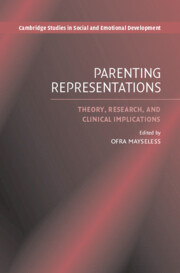Book contents
- Frontmatter
- Contents
- List of Illustrations
- List of Tables
- List of Appendixes
- List of Contributors
- Preface
- Acknowledgments
- Part One Theoretical Perspectives
- Part Two Research Applications
- Part Three Clinical Implications
- 9 Intergenerational Transmission of Dysregulated Maternal Caregiving: Mothers Describe Their Upbringing and Childrearing
- 10 Good Investments: Foster Parent Representations of Their Foster Children
- 11 Intergenerational Transmission of Experiences in Adolescence: The Challenges in Parenting Adolescents
- 12 Interplay of Relational Parent–Child Representations from a Psychoanalytic Perspective: An Analysis of Two Mother–Father–Child Triads
- 13 Why Do Inadequate Parents Do What They Do?
- Index
- Cambridge Studies in Social and Emotional Development
- References
9 - Intergenerational Transmission of Dysregulated Maternal Caregiving: Mothers Describe Their Upbringing and Childrearing
from Part Three - Clinical Implications
Published online by Cambridge University Press: 10 July 2009
- Frontmatter
- Contents
- List of Illustrations
- List of Tables
- List of Appendixes
- List of Contributors
- Preface
- Acknowledgments
- Part One Theoretical Perspectives
- Part Two Research Applications
- Part Three Clinical Implications
- 9 Intergenerational Transmission of Dysregulated Maternal Caregiving: Mothers Describe Their Upbringing and Childrearing
- 10 Good Investments: Foster Parent Representations of Their Foster Children
- 11 Intergenerational Transmission of Experiences in Adolescence: The Challenges in Parenting Adolescents
- 12 Interplay of Relational Parent–Child Representations from a Psychoanalytic Perspective: An Analysis of Two Mother–Father–Child Triads
- 13 Why Do Inadequate Parents Do What They Do?
- Index
- Cambridge Studies in Social and Emotional Development
- References
Summary
Abstract
We present quantitative findings and detailed case histories that reveal the links between mothers' representations of their own attachment relationships (assessed in the Adult Attachment Interview (AAI)) and their representations of themselves as caregivers (Caregiving Interview). The sample comprised 57 middle-class mother–kindergarten-age child dyads. The children's attachment classification with mother was assessed in a laboratory reunion. Mothers' description of one or more elements of a “rage pattern,” defined as physical or verbal abuse, unpredictable rage, and/or substance abuse on the part of their own parents, was coded from the AAI in addition to their state of mind. Results showed that 87% of mothers of disorganized-controlling children reported elements of the “rage pattern” in their upbringing while only 20% of such mothers were classified as Unresolved with respect to mourning or trauma. Three case summaries show clear parallels between the mothers' descriptions of their upbringing, their own childrearing representations, and the type of controlling (role-reversed) behavior shown by their child during reunion. The findings suggest that mothers' representations of threat and helplessness, past and present, provide a powerful and parsimonious approach to understanding intergenerational transmission of disorganized caregiving and attachment patterns.
In this chapter, we explore the links between dysregulation of the caregiving system across two generations and the development of disorganized and controlling attachments in early childhood. The findings bear directly on a growing literature in the field of attachment regarding the second-generation effects of a mother's own childrearing and attachment history.
- Type
- Chapter
- Information
- Parenting RepresentationsTheory, Research, and Clinical Implications, pp. 265 - 295Publisher: Cambridge University PressPrint publication year: 2006
References
- 18
- Cited by



